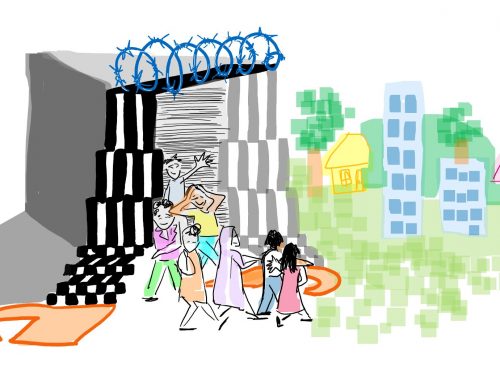Jerome Phelps
Strategy and advocacy consultant, and former Director of International Detention Coalition and Detention Action
The summer of 2013 was a very different world. President Obama was on course to sweep to a second term. ‘Brexit’ was a neologism likely to be forgotten. Mayor of London Boris Johnson was directing his attention to bendy buses and the garden bridge. The Mediterranean was a summer holiday destination, rather than a mass grave for migrants, and pandemics were just one more distant anxiety.
It was also the time that the UK’s use of immigration detention peaked, with over 4,000 migrants bedding down every night in the 12 detention centres, and countless prisons, around the country. The Home Office had opened five new detention centres since 2001, and was developing further plans to expand to 5,000 detention places.
The last seven years have been a time of catastrophic setbacks for progressive politics and human rights. Yet in the same period, under a series of Conservative governments consumed by reducing migration and propagating anti-migrant rhetoric, the UK has turned decisively away from its obsession with immigration detention.
A political problem
Even before the pandemic, the numbers of people in detention had dropped by around 60%, to 1,637 at the end of December 2019. Asylum-seekers are no longer routinely detained throughout the process on the notorious Detained Fast Track, suspended since June 2015 and dead in the water. While the UK has not followed Spain in emptying its detention centres during the pandemic, numbers have dropped further, to 313 in May 2020. The Government has announced that Morton Hall detention centre in Lincolnshire will cease operating next year and return to being a prison, the fifth detention centre to close since 2015. Since August 2020, the notorious Yarl’s Wood is no longer used as a detention centre; given its low rate of occupancy over the last two years, it is doubtful whether it will return to its former use.
Detention is now generally seen as a political problem. Ministers have stressed that the reduction in detention places ‘is a key aspect of the series of reforms the government is making across the detention system’, and emphasised that the Government is ‘committed to going further and faster in reforming immigration detention’. Instead of boasting of toughness in locking up ‘foreign criminals’, Ministers speak of piloting community-based alternatives to detention with civil society. Senior Conservative backbenchers, including Andrew Mitchell and David Davis, are leading calls for a 28-day time limit.
The battle is not won. 300 is still far too many people for the Home Office to seek to detain throughout the pandemic, while returns to most countries of origin are impossible. The Home Affairs Committee in July 2020 found it ‘troubling’ that 40% of people still in detention had indicators of significant vulnerability and risk from Covid-19. Despite sustained cross-party political pressure, the Government still refuses to introduce a time limit: the UK remains isolated in Europe in practising indefinite detention.
Nevertheless, a major reversal has taken place in the direction of travel of UK detention policy, which is antithetical both to regional trends in the EU, and to the Home Office’s overall approach to migration. It is important to understand how the tide of expanding detention was reversed, particularly at a time when the pandemic is posing unprecedented opportunities for a radically reduced detention system.
Civil society mobilisation
It is no coincidence that the period of this shift coincided with sustained civil society mobilisation and collaboration to delegitimise the use of detention. My analysis of the detention reform movement over last ten years, based on interviews with key stakeholders and published here, finds reason to believe that the collapse in government confidence in detention is to a large extent the result of civil society campaigners, including migrants themselves, simply winning the argument.
External factors helped this change, but are not enough to explain it. Home Office budget cuts were certainly a factor – detention is hugely expensive. But governments can always find money for political priorities, as the Covid-19 response is again demonstrating. The Panorama revelations of abuse by detention centre guards, along with the shock of the Windrush scandal, had a toxic effect on the legitimacy of detention – but only because that legitimacy was already under intense scrutiny. Previous scandals in the noughties had had little political impact.
What changed was sustained and effective pressure from civil society. Campaigners, charities, faith groups, lawyers, individuals, institutions and (crucially) migrants with experience of detention collaborated strategically over many years to transform the political debate. They succeeded in both making detention a political problem, and in setting the narrative for other actors to follow.
Effective tactics
Campaigners told a consistent and compelling story about the injustice of indefinite detention and the need for a time limit. It was a story that could reach new and influential audiences beyond the migrants’ rights movement, without alienating core supporters by watering down messaging in pursuit of the political middle ground. The story was told in different ways by migrants protesting in Yarl’s Wood, by faith leaders making public statements, and by HM Inspectorate of Prisons in their monitoring of detention centres, but the central narrative and demands were the same. This narrative of individual liberty from arbitrary state power has traction across the political spectrum, even where there is hostility to migration and human rights. Yet it could still mobilise the passionate supporters of migrants’ rights, including migrants themselves, without whom the issue would have remained marginal.
At the core of this process was the Detention Forum, a diverse network set up in 2009 to challenge the legitimacy of detention. The Forum was by no means responsible for all the crucial interventions, and tactfully never sought to be a high-profile public actor in its own right. But its wide membership across the country to a large extent came to base their tactics on the shared strategy and theory of change of the Forum, and doubtless few actors working on detention reform were not in close contact with at least one Forum member.
There was no single campaign for detention reform, and no-one owned indefinite detention as an issue. NGOs ran different campaigns around particular groups in detention; protests highlighted particular issues; messaging was not centrally policed, and varied considerably. But hashtags were shared, open source materials developed, and many Forum members spent considerable time on the telephone or on trains to engage and support groups around the country to get involved. New groups were free to pick up the issue and campaign in their own way; some joined the Forum, others didn’t. In practice, most people most of the time were telling versions of the same, compelling, story.
All this was, to an extent, foreseen by the Forum. A protracted, painful and distinctly sobering strategy exercisethroughout 2012 identified that Forum members had none of the necessary contacts to convince Ministers or the Home Office to change. Detention NGOs and campaigners emphatically did not have the ear of government, and neither did their friends. So a strategy was developed to build a broad civil society coalition, involving allies with more authority – politicians, faith leaders, institutions.
Having a wide range of allies meant that a wide range of tactics could be used in different spaces and times. The Detained Fast Track was resistant to both campaigning and government advocacy (it was seen to ‘work’ in getting asylum-seekers removed, so there was no interest in finding out whether it was doing so fairly), but it proved vulnerable to a wide-ranging legal challenge by Detention Action. City of Sanctuary could bring to the issue communities around the country who cared about asylum, while These Walls Must Fall mobilised grassroots groups for radical activism at the local level. Visitors groups and legal and medical organisations gathered and analysed the evidence of the harm of the detention that was the basis of everything else.
Crucially, the movement was initiated and increasingly led by people with experience of detention. Indefinite detention had become normalised because it was applied to non-people: the ‘foreign criminal’, the ‘bogus asylum-seeker’. It became problematic because people stepped out from behind these dehumanising tags and told their stories, not as victims but as experts-by-experience able to offer policy solutions. The initial push for a campaign against indefinite detention came from migrants in detention. Early reports and campaigning foregrounded their powerful testimony about their experiences. By the time of the parliamentary inquiry in 2015, which brought unprecedented cross-party political pressure and media interest to the issue, experts-by-experience were the dominant voices, both at the evidence sessions of the inquiry and in the subsequent media coverage.
As pressure grew for change, it became possible to talk constructively to the Home Office about how they could move away from over-reliance on detention. The organisation I was leading at the time, Detention Action, was piloting a community-based alternative to detention for young men with previous convictions, demonstrating that they could be effectively supported in the community. UNHCR facilitated high-level conversations with the Swedish and Canadian governments about their own community-based approaches. The Home Office began to informally collaborate with our pilot, and gradually moved towards committing to develop alternatives.
As political pressure over indefinite detention grew, the Home Office repeatedly refused to introduce a time limit, or even to acknowledge that it practiced indefinite detention. But in 2015 it began closing detention centres, and it has continued closing them. In 2018, the Home Secretary promised in Parliament to work with civil society to develop alternatives, the beginning of a small but growing programme of pilots.
Long-term transformation
This points to the key challenge facing detention reform. Progress so far has been based on winning the argument on detention as a relatively niche sub-issue, while the toxic politics of xenophobic migration control continued elsewhere. But a sustainable long-term shift away from detention needs to be part of a wider shift in migration governance away from enforcement, towards engagement with migrants and communities. If detention is simply replaced by a hostile environment that excludes and abuses migrants in the community, it will be a pyrrhic victory.
However, the hostile environment has not been a success, from the Home Office’s own point of view: numbers of returns, including voluntary returns, have been dropping for several years. Alternatives to detention point the way to a potential long-term transformation of migration governance, towards a system based on the consent of communities and treating migrants with fairness and dignity. Such a system would have to look very different from the current one. The Government will not sign up to such a shift immediately. But the pandemic has made clear that society is as vulnerable as its most excluded members. Civil society will need to lead if we are to build back better; the detention reform movement provides some clues as to how.
Jerome’s paper ‘Immigration Detention Reform in the UK 2009-19‘ is available here





